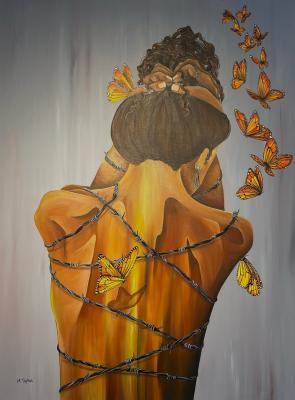“I didn’t want to be an artist.”
Mallory grew up in an artistic home. Her dad was a full-time artist and her hero. Because her father was so accomplished, appearing in places like the Smithsonian, she tried hard not to be an artist at first. She originally got a degree in speech pathology and wanted to go into the medical field, however, art was her calling.
When she accepted the call, Mallory dreamed about doing an art show with her dad. She and her father finally entered a show together, and she entered under a different name, so she wouldn’t be in her father’s shadow. Her painting sold for 5 more dollars than her father’s, that solidified her decision to finally be an artist.
came into her own as an artist raised in the Oklahoma Indian Art Gallery, yet she realized that she did not see much Indigenous representation in art. Because of her father’s art, she grew up thinking she was the norm, but later discovered she wasn’t.
“I like finding the balance between positive and negative.”
Mallory has developed a reputation of painting nude women, especially their backs. She says there’s nothing stronger than a woman’s back, that they are so strong and powerful. She also does work featuring women wrapped in barbed wire or doing active things. Her paintings are pretty looking, with bright colors and floral aspects, but oftentimes dark in subject matter. It takes great strength to be soft.
Originally Mallory wanted to be a realist painter,but her style turned out more so as Indigenous surrealism. A lot of her style is due to the fact that she is self-taught. Her art comes out the way she sees the world. It’s realism, but her realism, not going by any laws or rules.
Mallory expressed experiencing several barriers as an artist, including the oversexualization of women in art. Oftentimes, people call her “Pocahontas”. While Mallory paints a lot of nude women, she doesn’t do it for shock value and considers it intimate art. What she really wants to do is paint full nude, but she avoids painting women fully nude. With the Missing and Murdered Indigenous Women (MMIW) movement, Mallory questions if her work, even with semi-nude women, is contributing to that oversexualization of Indigenous women.
“I want to be considered an artist who happens to be Indigenous.”
Something else that has been difficult for Mallory is not carrying a Certificate Degree of Indian Blood (CDIB) card. No one in her family carries one. Without one, galleries, museums, and listings can’t consider Mallory an Indigenous artist. Instead, she is classified as a South Western artist.
Indigenous folks are the only race that requires certification from the government to be considered authentic artists. The Indian Arts and Crafts Act of 1990 was implemented to protect Indigenous artists, but Mallory feels like this is a way for the federal government to tell her identity.
Despite her struggles with legally being considered an Indigenous artist, Mallory was the first Cherokee Holiday Artist in 2019 without a CDIB card. That was huge because the Cherokee National Holiday Art Show took on that fight; it was them who would face the legal consequences of publicly listing Mallory as a Cherokee artist without a CDIB card. She ended up getting death threats because she took the place of an artist with a CDIB card. This was just one instance of the lateral interracial violence she sometimes experiences.
Mallory is firm in her identity. Sometimes she receives pushback from critics about her subject matter (for example someone complained about why a cell phone was in a painting set in a sweat lodge). She allows for the symbolism and subject matter to speak for itself, instead of trying to defend her identity.
Mallory believes the purpose of art is for education, beauty, and storytelling. For her personally, she wants her art to challenge ways of thinking. Whether someone hates her art or someone loves it, it means it was still impactful. She wants her art to make them think, for them to have a conversation through her art. Her goal is to open people’s minds.


